Trees Birds Mammals Fish Amphibians Reptiles
Wild Algarve
Bookshop
Flyfishing on Rivers in Wales
Here is a small selection of the many gamefishing rivers of Wales, with our tips on techniques, tackle and tactics to help enjoy these flyfishing venues.
River Teifi
Whether your particular interest is in trout, salmon or sea trout fishing, you are sure to find challenge and reward in the Teifi Valley.
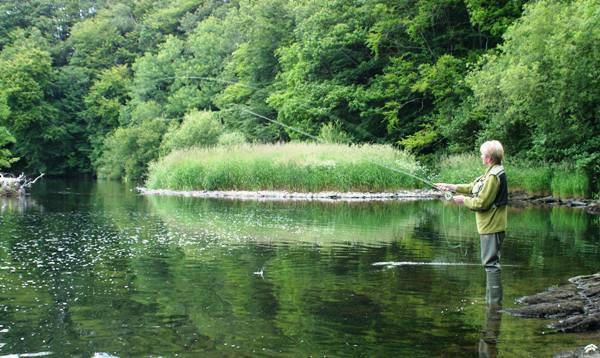
Sue using the single-spey cast while trout fishing on the River Teifi
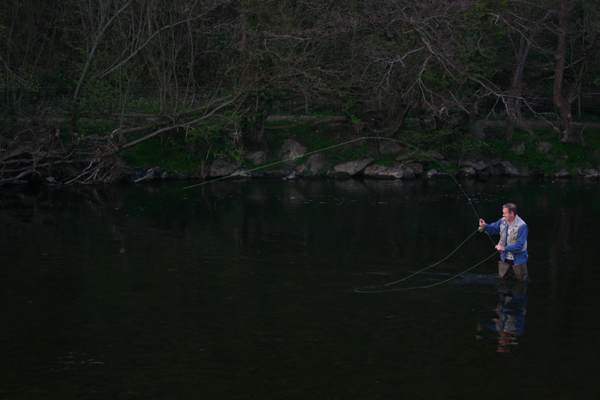
The Teifi is quite a big river with many deep pools, swift glides, waterfalls and rocky gorges. It is very rich in insect life, and so offers a fine variety of fishing for trout, sea trout, salmon and even the occasional grayling. Sea trout (sewin) run from April until October, with the cream of the sewin fishing between late May and the end of August.
Notable catches in recent years include salmon to 23 lb (10.5kg,) sea trout to 17 lb (8kg,) wild brown trout to 5 lb (2.4 kg), and grayling to 2 lb 8 oz (1.3kg).
Based at Llandysul, the Llandysul Angling Association offers day, week and season permits on some 30 miles of the River Teifi, including in particular several world-famous salmon and sea trout beats. The trout fishing in the upper beats of the Association's waters is well known and was popularised by the late Oliver Kite, who made TV programmes there in the 1960s.
Where to Stay in the Teifi Valley
Hotels |
Porth
Hotel
Llandysul, Ceredigion SA44
4QS. The hotel sits on
the banks of the River Teifi and is a meeting place for local and
visiting anglers. |
01559
362202 |
Kings
Arms Hotel
High Street, Llandysul SA44 4DL |
01559
362265 |
Falcondale
Mansion Hotel
Falcondale Drive, Lampeter, Ceredigion SA44 SA48 7RX
Overlooking the Teifi Valley and ideal for the trout fishing on the
upper beats of Llandysul A A. All rooms en-suite. |
01570
422910 |
Emlyn Arms Hotel
Newcastle Emlyn, Carmarthenshire. |
01239 710317 |
Caravan and Camping Sites |
Afon Teifi Caravan Park
Newcastle Emlyn, Carmarthenshire
SA38 9HT |
01559 370532 |
Pilbach Caravan Park
Betws Ewan
Rhydlewis
Llandysul SA44 5RT |
01239 851434 |
Talwerydd Touring Caravan and Camping Park
Penbryn
Sarnau, Llandysul SA44 6QY |
01239 810322 |
Cenarth Falls Holiday Park
Cenarth, Near Newcastle Emlyn SA38 9JS |
01239 710345 |
Argoed Meadow Caravan & Camp Site
Argoed Farm, Cenarth, Newcastle Emlyn, Carmarthenshire SA38 9JL. |
01239 710690 |
Coed y Cwm
Cwm Cou, Newcastle Enlyn, Ceredigion SA38 9PQ. |
01239 710327 |
Coynant
Cenarth, Newcastle Emlyn, Cardiganshire SA38 9JX.
Tel. 01239 682517 |
|
Hafod Brynog Caravan and Camping Park
Ystrad Aeron, Felinfach, Lampeter, Ceredigion SA48 8AE. |
01570 470084 |
Travel
Depending on traffic conditions, the Teifi Valley is about a four-hour drive from London (five
hours should allow time a break), less than two hours from Cardiff, and
forty minutes from Aberystwyth.
From London and South Wales via the M4 / A48 through Carmarthen:
The M4 ends at Pont Abraham, just outside Swansea, but a motorway-standard extension (the
A48) continues to Carmarthen. Follow the Carmarthen Eastern Bypass towards Cardigan,
taking the Cardigan Road (A484) through Conwyl Elfed and on to Saron, at
which point Llandysul is signposted to the right. (The A484 continues to Newcastle
Emlyn and finally to Cardigan on the Teifi Estuary).
From the Midlands and North Wales via the A487 through Aberystwyth:
From Aberystwyth take the A487 south towards Cardigan. At Cardigan take the A485 east
towards Newcastle Emlyn, and after six miles you will cross the river Teifi at
Cenarth, and continuing a further 4 miles on that road brings you to
Newcastle Emlyn. Continue for a further four miles towards Carmarthen until
you see Llandysul signposted to the left.
By train:
Our nearest railway stations are Carmarthen (from London) and Aberystwyth (from
Birmingham). Bus services run from these stations to Llandysul and Newcastle
Emlyn by day, and taxi services are available at all times.
Llandysul is a small market town with a one-way circulating traffic
stystem. The Porth Hotel is in Church Street, right beside the River Teifi.
River Severn - Upper Reaches
The Severn rises on Plynlimon, in mid Wales, and flows for 180 miles through Llanidloes, Llandinam, Caersws, Welshpool and Newtown before being joined by the River Vyrnwy and entering England, winding its way past Shrewsbury, Worcester and Gloucester to its wide estuary in the Bristol Channel.
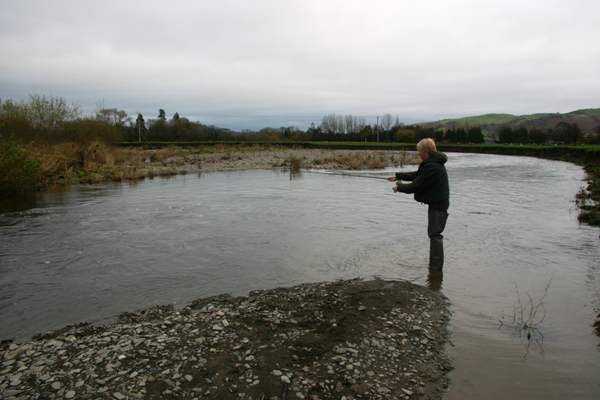
Sue Parker fishing the upper Severn near Llandinam
Tributaries
The upper Severn has several tributaries that provide good trout fishing; these include the Rhiw, Mule, Tanat, Camlad, Vyrnwy and Clywedog. Grayling have also colonised several of these tributaries, providing good autumn and winter fishing.
Salmon fishing
Most of the salmon fishing is in England, between Worcester and Shrewsbury, and there are still reasonable numbers of spring salmon on this the largest river in England and Wales, but occasionally salmon are caught as far upstream as Caersws, where a single-handed rod is quite adequate. In Wales, however, the Severn is mainly a trout and grayling river and these are the species that we concentrate on.
Trout and grayling fishing
Although great fun, the trout fishing on the upper Severn is eclipsed nowadays by the outstanding opportunities for catching big grayling. We have caught fish to over 2 lbs there and seen a number of fish much larger. It's a great river system for dry-fly fishing, because if the main stem is too high and coloured you can always move on to one of the smaller tributaries and find water clear enough for fish to be able to seek surface food. Much of the river is open and fairly shalow, making it a good place for beginners to practise the art of river fishing.
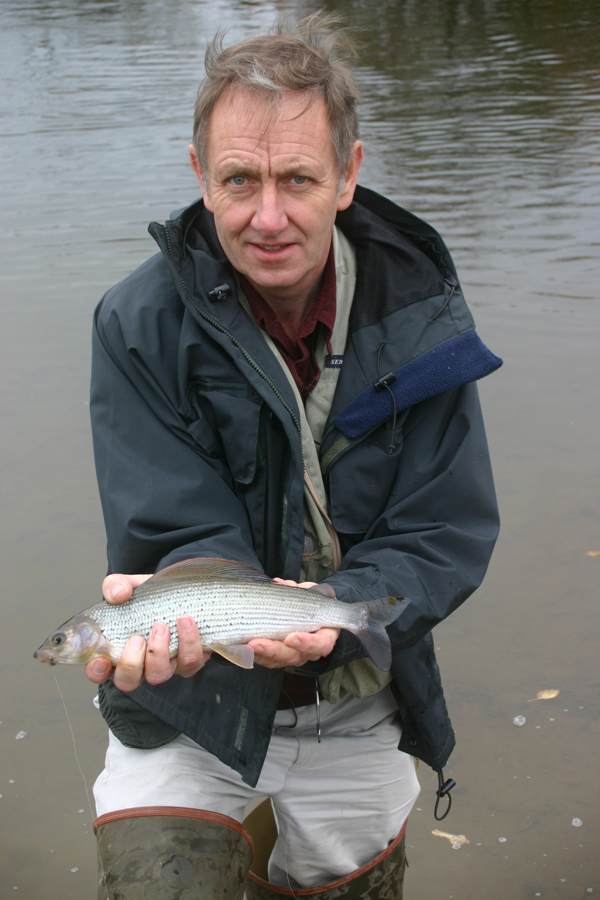
Pat O'Reilly with a nice grayling from the Severn at Caersws
An AFTM #4 or #5 rod is ideal for summer fishing, but on the main river in spring and early autumn it is often very windy and an AFTM #6 outfit can be an advantage. Fly hatches are rarely so dense that fish become preoccupied with one insect species, and so a general representation of the prevalent natural insects is usually quite sufficient. The fast-water olives such as Iron Blue (now rather scarce), Large Dark Olive and Medium Olive are the main spring upwinged flies, with Grannom Sedges and summer sedges such as Large Cinnamons providing good sport later in the year. In autumn and winter the rises are mainly to small stoneflies, and so we have great success with a Grey Duster in sizes 16 and 18. (Pat O'Reilly's bestselling illustrated book Matching the Hatch covers all of these aspects.)
What to expect
The upper Severn is a prolific fishery, and in a typical spring or autumn day a competent flyfisher could catch between 5 and 15 sizeable trout in a day. The grayling usually shoal, and so if you find a good-sized pod in autumn it is often possible to catch half a dozen or more (average weight 3/4 lb with the occasional fish over 2 lbs, although fish in a shoal tend to be more or less of the same size, with the larger fish shoaling in smaller numbers) without moving location. Summer fishing can be slow during the day, but unless the wind sweeps files away from the river it is usually possible to catch a few nice trout (1/2 lb is a good average for the adult fish) as the sun is setting.
Angling clubs control most of the upper Severn, and low-cost permits are available from shops/post offices in towns throughout the valley. The Environment Agency has a 1/2 mile stretch downstream of the sewage treatment works near Llanidloes that is free fishing (but you must have a valid rod licence, of course).
River Taff
The South Wales Valleys rivers rise in hilly terrain. They are relatively short, steep and 'flashy', and drop back rapidly after spates. The South Wales coalfields are silent now, and their marks on the landscape are healing. In many places the narrow valleys remain unaltered by the industrial heritage of the area. Cleaner waters now flow down from the hills, and all of these rivers have trout stocks in their upper reaches. But one of the greatest fisheries achievements in Wales has been the restoration of salmon and sea trout runs on the River Taff. This recovery has been greatly assisted by a programme of fish-pass construction.
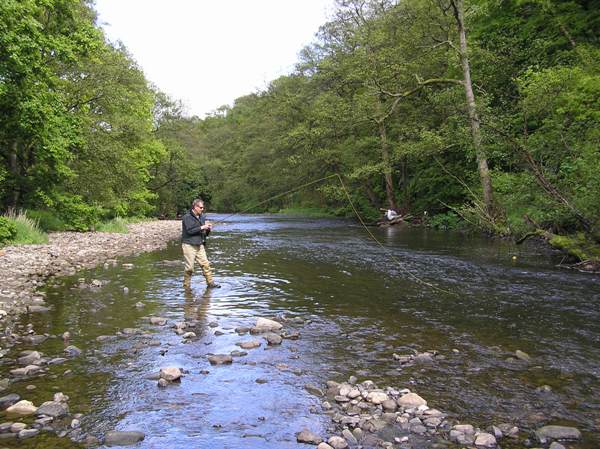
Nymph fishing on the middle reaches of the River Taff
The Taff rises on the Old Red Sandstone escarpment of the Brecon Beacons at 975 ft. above sea level and flows some forty miles through Merthyr Tydfil, Abercynon, Pontypridd and Cardiff before entering the Severn Estuary. A barrage constructed by the former Cardiff Bay Development Corporation, has a fish pass that is intended to allow salmon and sea trout to access the river. In the lower reaches trout and grayling thrive in a mixed fishery; the upper river is a very productive trout fishery.
Tributaries
The Ely rises just to the north of Tonyrefail and flows south-east through Talbot Green, Pontyclun and Miskin before veering to the east past Peterston-super-Ely, through St Fagans and into Cardiff Bay at Llandough. Salmon and sea trout run the lower reaches, which also hold mixed stocks of trout, grayling and coarse fish, and with a fish pass operational at Treforest Weir they are now able to gain access to much more of the main river and its spawning streams. The headwaters are home to wild brown trout.
The Taff Bargoed rises near Merthyr Tydfil and joins the Taff near Treharris; it holds stocks of wild brown trout.
The Rhymney rises two miles north of Rhymney Reservoir and flows south through New Tredegar, Bargoed, Ystrad Mynach and Caerphilly before veering east to join the Severn Estuary in East Cardiff. This river holds trout, grayling and the occasional sea trout.
Trout and grayling fishing
Much of the land of the South Wales Valleys is quite fertile, and so the rivers harbour a good range of insect life. Trout grow to reasonable size - 3/4 lbs is about average - on the lower and middle reaches of many of the rivers, feeding on a mixed diet of aquatic and terrestrial life. In spring there are olives and iron blues, while summer brings the blue-winged olive and pale watery as well as large sedge flies, most noticeably in the evenings. Beetles and heather flies are important summer food sources for the wild trout of the headwaters.
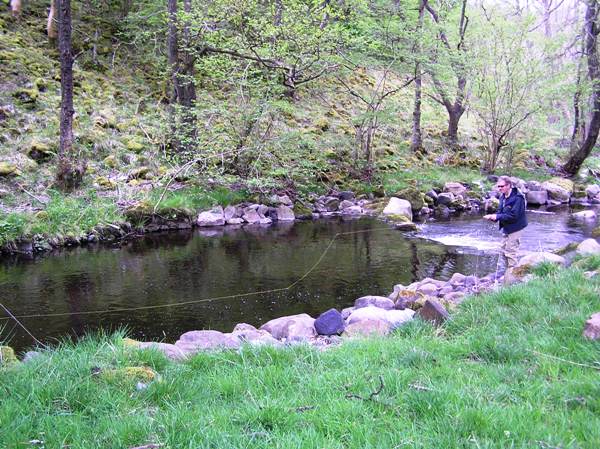
Dry-fly fishing on the Taf Fechan, a small tributary of the River Taff
For trout and grayling fishing, a 9 ft. rod rated at AFTMA #5 or #6 is ideal. Lighter tackle and preferably a shorter rod are recommended for the smaller tributaries such as Taf Fechan, which flows out of Pontsticill Reservoir, above Merthyr Tydfil. In low-water conditions, the water runs very clear in the upper reaches, and so a fine leader is advisable if you want to tempt the wily wild brown trout, some of which are well over the pound mark.
In all but the heaviest of spates the Taff can be fished for salmon with a single-handed rod. As the water is usually fairly clear and not particularly deep, flies in sizes 10 to 6 are usually big enough. Dark flies seem to work well in clear water, but an orange fly, such as Ally's Shrimp, is often preferred during spate conditions.
River Dee
The Welsh Dee rises on Gamwedden Mountain in Snowdonia National Park, to the west of Bala Lake through which it flows before it is joined by the River Tryweryn at Bala. From there the Dee heads eastwards past Corwen and Llangollen before veering northwards through the Cheshire Plains to Chester and then on to Flint and the Dee Estuary. On its way the Dee picks up waters from several tributaries including the Tryweryn, which runs out of Llyn Celyn; the Atwen, which drains Llyn Brenig; and the Rivers Lliw, Twrch, Ceiriog and Alyn.
The River Dee probably provides the most varied of top-quality fishing opportunities anywhere in Wales. The grayling fishing, in particular, is outstanding, with large shoals of specimen fish offering superb winter sport. The Dee still has a spring salmon run, albeit not of the quality of two or three decades ago. Sea trout also run the Welsh Dee - mostly small fish but with a sprinkling of specimens into double figures. Sea-trout fishing on the Dee has long been neglected, but in recent years much more is being made of this exciting opportunity. There is also an important coarse fishery on the lower and middle Dee, with many of the clubs there offering both game and coarse angling.
The Dee is the most regulated of the Welsh rivers: reservoirs in its headwaters provide compensation releases for major water-supply abstractions in the lower reaches. As a result, over most of its length this river maintains good summer flows.
Rod catches
In 1994 the reported rod catch from the Doe was 729 salmon, of which 81 were taken before the end of May Seventy of these salmon weighed more than 15 Ib. Spring fish can enter the Dee as early as January, but to help conserve this dwindling component of salmon stocks winter fishing is no longer permitted. The runs of summer salmon are followed by grilse in July and then larger salmon once the river begins rising with the autumn rains.
On many stretches the brown trout reach between 1/2 Ib. and 3/4 Ib. at maturity, but much larger fish leave Bala Lake towards the end of the season. The River Alyn, a Dee tributary, has reasonable numbers of brown trout over 3/4 Ib.
Grayling of 2 Ib. are very common indeed on the River Dee, and fish of twice that weight have been reported in recent years. (Some very large grayling were caught in 1990 when the World Flyfishing Championship was held on this river.) Dee anglers greatly value the exceptional grayling fishing on their river, and almost invariably every fish they catch is carefully returned alive. For this reason stocks are not exploited and it has not been found necessary to introduce a size limit for grayling. The Dee also yielded 398 sea trout during 1994.
The larger fish tend to run early in the season and again towards the close, with first-year (whitling) sea trout making up the bulk of the summer run.
River Usk
The Usk is one of Wales's finest game-fishing rivers. The river is fast-flowing and heavily wooded in its upper reaches, becoming a little more gentle and open as it passes Brecon and Crickhowell, but it is still a very lively river even at Abergavenny. From there the river flows south through the town of Usk before turning west to enter the Bristol Channel at Newport.
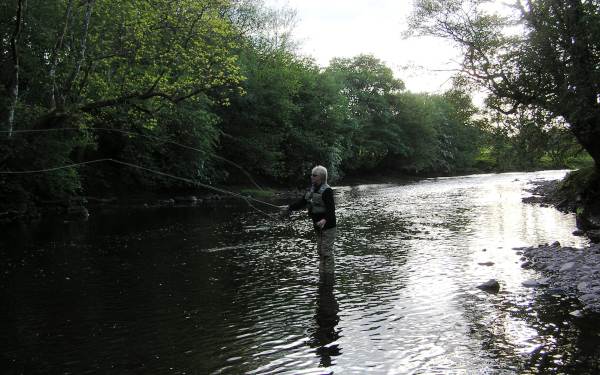
Summer flyfishing on the Usk above Brecon
Over most of the lower and middle river the fishing is reasonably easy going, although in places the banks are very high; however, the rocky gorges of the upper Usk can be difficult going for all but the most nimble of anglers.
Usk tributaries
The Llwyd is a trout stream. Having recovered from industrial pollution, it now holds brown trout and is home to the otter and the vole. Although much of the Llwyd is bordered by urban developments, once on the river bank it is easy to lose yourself in the rough beauty of this wild stream.
Berthin Brook enters the River Usk half a mile above the bridge in the town of Usk. It contains mixed stocks of coarse fish and brown trout.
The River Ebbw rises at Llangynidr and Carno Reservoirs on Llangynidr Mountain, and it flows some 30 miles to its meeting with the Usk below Newport Docks. On the way it passes defunct collieries and steelmaking sites, which in the past killed off virtually all life in the river. Things have changed now: the water quality is much improved, and the Ebbw and its tributaries are home to kingfisher, dipper and mallard as well as some fine brown trout and the occasional salmon.
The River Sirhowy rises to the north of Shon Sheffrey Reservoir, above Tredegar. It flows through Blackwood and Pontllanfraith before joining the Ebbw near Risca. This river provides good trout fishing.
The Olway brook is a lowland tributary of the Usk. It rises near Raglan and is fed by several feeder streams on its ten mile meander to the Usk at the town of Usk. It is another good trout stream.
Trout fishing
The River Usk has long been renowned for its wild brown trout, which on many beats average around 3/4lb. The Usk's fame as a trout fishery can be ascribed largely to its abundance and diversity of fly life. Upwinged flies there include large dark olive, March brown, medium olive, small dark olive, late March brown, iron blue, blue-winged olive, olive upright, mayfly, yellow may dun, large brook dun and autumn dun. Large yellow sally stoneflies hatch in good numbers in summer and the trout sometimes rise steadily to take them even in the midday sun. Note that the March brown hatch is much better on fast, shallow stretches, so these kinds of beats are a very good bet for early spring fishing.
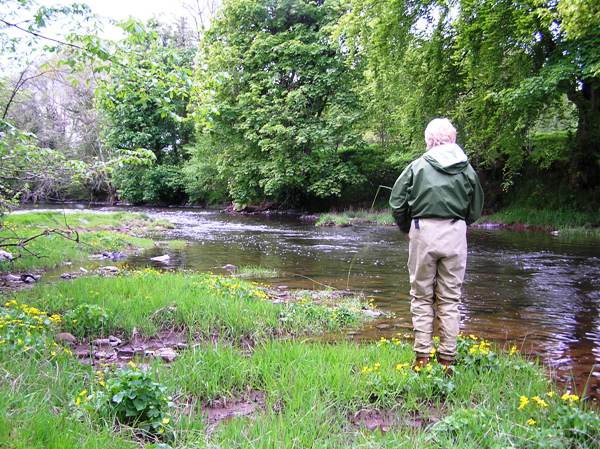
Sue Parker fishing for Usk trout in springtime
Evenings in summer bring good hatches of large sedge flies, which in turn bring trout (and the occasional sea trout) to the surface.
An AFTM #5 or #6 rod of 9 or 9.5 ft in length is about right on the main river, while a shorter, lightweight outfit may be advantageous on some of the smaller tributary streams. The trout sometimes get preoccupied with a particular life stage of a major hatch - this often happens in mayfy time, for example - and working out whether they are taking nymphs, emergers, duns, egg-laying spinners or spent spinners can make all the difference between success and failure. (Pat O'Reilly's bestselling illustrated book Matching the Hatch covers all of these aspects.) Our advice is: if in doubt, try a spent spinner first!
Salmon fishing
The River Usk is now Wales's premier salmon river, with a rod catch of around 1000 salmon per season. A double-handed rod is a great help on this large and fast-flowing river, and in all but low water a sink-tip or even a sinking line will be necessary to get down to where the fish are. There is a strong 'catch-and-release' culture on the Usk, fostered not only by the fishery owners but also by the Wye and Usk Foundation, a charitable Rivers Trust that works to improve and protect the habitats and fish stocks of the Usk and its neighbouring river the Wye.
River Wye
Portmanteau salmon of over 40 lb are part of the history of this great river. Although the numbers and size of Wye multi-sea-winter spring fish are now greatly depleted, the lower and middle Wye still provides some good salmon fishing throughout the season and there is excellent trout and grayling fishing, particularly on the middle and upper Wye.
The River Wye rises at 2200 ft. on the slopes of Plynlimmon in the Cambrian Mountains and drains a catchment area of 1600 square miles. The Wye flows 156 miles on its journey through Rhayader, Builth Wells, Hay-on-Wye, Hereford, Ross-on-Wye and Monmouth before entering the Severn Estuary at Chepstow. Its major tributaries include the Monnow, Lugg, Irfon, Ithon and Llynfi. A 'flashy' rain-fed river, over much of the Wye's length pools and riffles alternate as the course winds through some of the most spectacular countryside in Britain. Reservoirs in the Wye catchment also provide good sport, some offering wild trout fishing in beautiful surroundings, albeit for fish of moderate size.
The Wye and Usk Foundation works to improve and protect the Wye's fisheries, and in particular to restore the wild brown trout populations and the runs of salmon. The foundation has carried out major habitat restoration works in recent years with marked improvements in juvenile trout and salmon populations.
Wye Tributaries
The Monnow, one of the larger Wye tributaries, flows down through Grosmont and Skenfrith before entering the Wye at Monmouth. This river rises in the upland area of the Black Mountains, but over much of its length it flows through a gentle fertile valley. A good hatch of mayflies in spring makes the Monnow an excellent early season trout fishery.
The Honddu (not to be confused with the Usk tributary of the same name) flows through Llanthony and Llanfihangel Crucorney, entering the Monnow on its right bank. This is a good little trout stream.
The Llynfi flows out of Llangorse Lake and enters the Wye on its right bank at Glasbury-on-Wye. This stream holds stocks of trout and grayling.
The Irfon, a major tributary of the Wye, cuts an arching course, first flowing south and then turning north-easterly on its journey through Llanwrtyd Wells and Llangammarch Wells before joining the Wye at Builth Wells. In its upper reaches the Irfon is very rugged, but further downstream it is a good trout and grayling fishery and can provide some opportunity for salmon fishing in late season.
The Ithon, a left-bank tributary, is a little smaller than the Irfon and it rises in less rugged terrain. The Ithon flows through Llanbister and on past Llandrindod Wells before joining the Wye just below Newbridge-on-Wye; it is mainly a trout and grayling fishery, but in good years a few salmon are caught in this river towards the end of the season.
The River Elan was impounded in its upper reaches a century ago to provide water for Birmingham. Below the reservoirs the river provides trout fishing as it flows for six miles or so down to the Wye near Builth Wells.
The Marteg, a short upland tributary, enters the Wye a few miles upstream of Rhayader. It is a lovely place to fish for wild brown trout, although monsters should not be expected there.
The Lugg is the largest of the Wye tributaries and is mainly noted as a trout and coarse fishery. Rising near Llandrindod Wells, it meanders through a fertile lowland valley before joining the Wye just below Hereford.
The Troddi (Trothy) runs from the Black Mountains near Abergavenny more or less in a straight line across the fertile farmland of Monmouthshire before entering the Wye about a mile below the confluence of Wye and Monnow. It is not more than five metres across in most places but runs quite deep (typically between one and three metres) especially in the lower ten miles. For much of its length it has high banks and plenty of overhanging trees. There is a good mayfly hatch peaking most years in the first week in June, and there are plenty of midges and alders and some sedges.
Apart from eels and minnows (and native crayfish) there are only wild brown trout above Mitchel Troy. They average 8oz to 12 oz with plenty of fish of 1lb+ and a few of more than 2lbs, especially in lightly fished stretches.
Fly fishing is testing because the narrow stream, high banks and trees make silent approach and casting difficult.
Trout fishing
With wild trout and grayling occasionally topping 3 lb the middle and Upper Wye fisheries are among the best river fisheries in Britain. The Wye upstream of Rhayader is acidified and fishing in the highest reaches is not so productive (although efforts to mitigate the acidification may change the situation); however, some of the upper tributaries, notably the Marteg, provide lively sport for smallish but truly wild brown trout.
The insect life of the Wye system is very diverse.
Some 20 species of upwinged flies have been reported from the Wye, including the large dark olive, medium olive, small dark olive, late march brown, iron blue, blue-winged olive, mayfly, yellow may dun, purple dun, large brook dun and autumn dun. Parts of the Wye have particularly good hatches of olive uprights, a spring and early summer fly common on many Welsh rivers. Sedge flies are also abundant in the lower reaches. (Pat O'Reilly's bestselling illustrated book Matching the Hatch covers all of these aspects.) In the headwaters, much of the river is acidic: look out for stoneflies, as they are a reasonable guide to which tributaries provide the best sport.
For Wye trout, Iron Blue, Grey Duster, Red Sedge and Kite's Imperial are good general dry-fly patterns. GRHE and pheasant tail nymphs are useful standbys for 'between hatch' fishing. Popular grayling flies include
Treacle Parkin and Red Tag, while for sub-surface fishing either shrimp patterns or Sawyer's Killer Bug are usually successful. Barbless grayling flies are increasingly being used by anglers on the Wye, and small dry flies can be very effective in low water conditions on crisp winter afternoons; stonefly imitations are particularly useful at that time.
A 91/2 ft. rod rated at #6 line is just about ideal for most of the trout and grayling fishing on the Wye and its larger tributaries. The grayling frequently top the two pound mark, so using a leader of less than 3 lb breaking strain is probably unwise - and hardly necessary in the swift-flowing autumn currents on the best grayling beats.
Sea trout are rarely reported from the Wye, although in part that may be because so few people fish for them.
Salmon fishing
The lower Wye is a big river and ideal for those who can manage sunk-line fishing with a double-hander, especially as the river fines down after a spate in spring and autumn. A floater or an intermediate will usually be fine for salmon fishing in summer.
Further up river, the pools are fairly deep and the riffles and glides fast, making it ideal summer flyfishing water. A double-hander is probably advisable if you are fishing from the bank; however, when fishing from one of the many croys or from a boat, a 91/2 ft. single-hander is fine provided it has enough backbone to cope with salmon in fastish water.
Tube flies are popular with Wye anglers, the advantage being that the same general pattern can be tied in a range of sizes and weights, from plastic tubes 1/2 inch (12 mm) long to 2 inch (50 mm) brass tubes for heavy-water. When fishing catch-and-release, as nearly all people now do on the Wye, a single-hook fly is preferable.
Top of page...
Excited by rivers and streams? So are we, and we're pretty sure you would find the Winding River Mystery trilogy of action-packed thrillers gripping reading too. Dead Drift, Dead Cert, and Dead End are Pat O'Reilly's latest river-based novels, and now they are available in ebook format. Full details on our website here...
Buy each volume in ebook format for only £2.47 on Amazon... Paperbacks also available on Amazon at £6.95 each. All proceeds go towards keeping the First Nature website online.
Please Help Us: If you have found this information interesting and useful, please consider helping to keep First Nature online by making a small donation towards the web hosting and internet costs.
Any donations over and above the essential running costs will help support the conservation work of Plantlife, the Rivers Trust and charitable botanic gardens - as do author royalties and publisher proceeds from books by Pat and Sue.